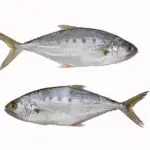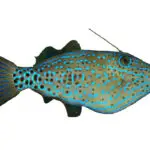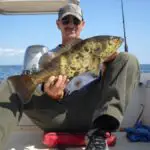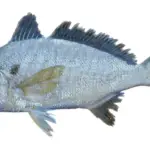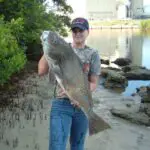Catching saltwater fish with a rod and reel is the most popular method of fishing, but there is another method that is quickly gaining popularity-bowfishing!
Bowfishing involves hunting fish with a bow and arrow, with a fishing line connected to the arrow that you reel in after the shot.
For decades, anglers in the midwest have been bowfishing for invasive species of carp, but in the past few years, bowfishing for stingrays along coastal states has become very popular.
Let’s take a closer look at this addictive way of fishing!
This post may contain affiliate links. As an Amazon Associate, I earn from qualifying purchases
Table of Contents
- Why Do People Bowfish for Stingrays?
- What Gear Is Required to Bowfish Stingrays?
- Where to Bowfish for Stingrays
- What Habitat to Look For When Bowfishing Stingrays
- Is It Better to Bowfish Stingrays During the Day or Night?
- What Do You Do With Stingrays After Shooting Them?
- Final Thoughts
- Related Posts
Why Do People Bowfish for Stingrays?
Although bowfishing is increasing in popularity year after year, many traditional anglers will often wonder why others will prefer to use bowfishing equipment for stingrays.
Shooting a stingray with a bow and arrow, however, actually has many benefits.

Besides providing a fun and unique experience, many people will bowfish stingrays for their table fare and the excellent meat they provide. The bowfishing equipment also helps to avoid the stingray’s stinger when caught and is great at covering shallow waters that stingrays love to call home.
Stingrays love to live in warm, shallow waters where they search for prey. This makes them perfect targets for bowfishing equipment, as the arrows are unable to penetrate deep water beyond 3′-4′ feet.
For those looking for a fun experience on the water with the potential of a great meal after a successful hunt, bowfishing stingrays can be a great option (and you can do it at night too!)
Related: Are Stingrays Hard To Catch? (And How To Avoid Them!)
What Gear Is Required to Bowfish Stingrays?
In order to bowfish for stingrays, you will of course need a bow. Many of these are specifically designed for bowfishing, and work well in wet and aquatic environments.
Don’t worry, you dont need to be an expert with archery. Most manufacturers offer bowfishing kits with everything you need to get started.
For stingrays, you do not need a very strong bow to be effective. Both compound and recurve bows work, you need one that has at least 30 to 40 pounds of draw weight.
It is also important to research if there are any minimum draw weight regulations in the area you will be hunting.

In addition to a bow, you also need a reel. Most bows that are designed for bowfishing already come equipped with a reel on the bow, but if you convert a regular compound or recurve you will need to buy a reel separately and attach it to your bow.
Just like a traditional fishing reel, a bowfishing reel will store your line but will also attach it to your arrow.
The reel will allow you to retrieve your arrow (and maybe a fish) after you shoot. The bowfishing line is different than traditional fishing and is much thicker and stronger.
In addition to a bow, reel, and line, you will also need the proper arrows. Bowfishing arrows are generally made of fiberglass or a carbon fiber/fiberglass composite.
They are very thick and heavy in order to allow them to dive deep into the water and shoot fish. Bowfishing arrows have barbed points that anchor a fish so that the arrow will not come loose while it is being reeled in.
Where to Bowfish for Stingrays
Bowfishing is legal in almost every state in the United States for non-gamefish or invasive species.
For native species such as stingrays, however, there are going to be differences in rules and regulations pertaining to bowfishing these unique fish.
Some of the most popular locations to bowfish for stingray include coastal waters around Delaware, Maryland, Virginia, North Carolina, Louisiana, Texas, and Florida.
Florida is often considered a bowfisherman’s ideal hunting ground as a variety of different species of stingrays are plentiful.
Where I live along the Indian River Lagoon, the average water depth is only about 3 feet deep. With miles and miles of sand flats and grass flats, it is a bow fishing paradise.
What Habitat to Look For When Bowfishing Stingrays
Stingrays prefer shallow water, making them an ideal target for bowfishing.
The shallow water will allow your arrows to properly penetrate the surface of the water and strike the fish before it has a chance to swim away.
The best place to target stingrays for bowfishing includes prime habitats such as sandy bottoms, mudflats, grass beds, along shallow reefs. Stingrays will often partially bury themselves in the sand or mud, making them hard to spot but easy targets if you can see their silhouette.

If you are having trouble locating stingrays, dont fret. Keep an eye out for other popular species to bowfish for like sheepshead and mullet.
Once you find their food source, the stingrays will not be very far away. Stingrays love to feed on crabs, mollusks, worms, crustaceans, squid, and smaller fish.
Is It Better to Bowfish Stingrays During the Day or Night?
It is very important to understand the rules for bowfishing in the area that you intend to hunt.
Some areas allow bowfishing to be done at night, while others only allow it to be done during the day. Some protected areas may not allow for bowfishing at all.
If you have the choice between the day or night to bowfish for stingrays, the night hours are much more productive and better for bowfishing. This is due to the stingrays being much more active during the night as they hunt for their food.
Stingrays can still be successfully shot during daytime hours, but they will not be as active and are much harder to spot.

At night, bow fishermen use artificial lights on the bow of their boats to illuminate the shallow waters and the stingrays in order to shoot them.
You may get lucky and see a flounder too!
What Do You Do With Stingrays After Shooting Them?
One of the few downsides of bow fishing for stingrays is the stingrays are killed or severely injured when shot with an arrow, so you cannot practice catch and release.
Even a stingray that is not fatally hit will most likely be injured to the point it cannot successfully hunt for food.
Because the stingrays cannot be released back into the water after being shot, most people will bowfish for stingrays in order to eat them afterward. Stingrays actually have an excellent taste and are considered to be great table fare once properly prepared.
If you do not want to eat a stingray, your best bet is to use traditional fishing equipment to catch them so that you can easily release them afterward.
When bowfishing, you will not be able to release them and must put the stingray to use rather than let it die and go to waste.
Other people I know will often bowfish for stingrays to use them for bait.
Any stingrays they shoot while bow fishing will then be cut up and used to bait their crab traps, made into chum, or used as whole bait to catch sharks and goliath grouper!
Final Thoughts
Bowfishing for stingrays is a great group activity and provides a change of pace from traditional hook and line tackle.
Be sure to check the regulations in your area, and remember to practice ethical hunting and fishing techniques.
Never shoot or take more than you intend to use. Good luck!
See Also: Using Mullet For Shark Bait? Follow These Tips!

Growing up in Florida, I’ve been surrounded by saltwater my entire life…and I love sharing my passion with others.
To learn more about why I started Saltwater Mecca, visit the ABOUT page.
Thank you for reading this article. Browse around & have some fun!

